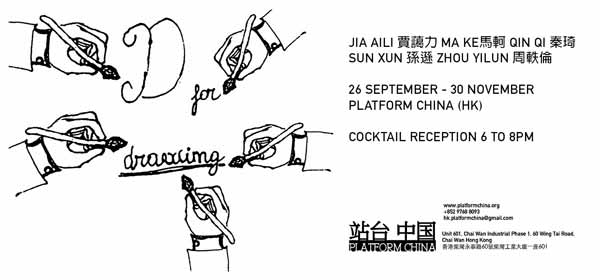
D for Drawingis a group project featuring works on paper by Jia Aili, Ma Ke, Qin Qi, Sun Xunand Zhou Yilun. Focusing on a technique the artists share in common, the show reflects thecentrality of drawing in each of their different practices as an essential and innate action.
Similar to Newman assertion, drawing is in fact pivotal to their artistic expressions, whether it isthe essence of their entire practice or a preliminary step towards the realization.
Fragmented drawings, sketches on paper and manuscripts inhabit Jia Aili’s creative process to the same extent as his painstakingly achieved canvases: the power of drawing as an irrationaland spontaneous act delivers the artist’s mental process and highlights the progress towardssought-after perfection. In Jia Aili’s world drawing stem out as an independent practice, it's anelement of his whole system.
A minimal approach to drawing is what differentiates Ma Ke. Provoking the reaction of theviewer and stressing the visual power of his technique, Ma Ke tries to convert his obsessionwith means of expression into concrete forms. His forms are nonetheless a way to pursue aspiritual elevation, they become a tool through which he questions the action of art-making and its meaning.
Qin Qi’s paper works wear the same fantasies of dream-life or still life views realized on hiscanvasses. The color is flat and paint less thick, but technique is not what we are looking at. Avisual thinker, Qin Qi represents a consciousness that goes beyond forms and shapes toreach remote meanings, evincing thus “that drawing that exists within painting”.
Sun Xun’s works are based on drawings. Ink drawings, charcoal drawings, pencil drawings: amultitude of drawings incorporating text within image is combined to create his meticulousanimations. Sequentially arranged one after the other, Sun Xun’s hand drawings are combinedto create a sense of movement and suggest the passing of time, the machination of history orthe irony of the moving image.
Considering drawing as well as creating art in general as a playful activity, Zhou Yilunepitomizes a sense of disjunction from traditional pictorial language and gives birth tocompositions that are borne of a processing of visual information, to convert to a differentformat. His paper works constitute a part of his production singular for its immediacy andstraightforwardness, as well as their grandiose imagery.
Showcasing different standpoints, the show expands from colourfully designed sets to mutedcombinations of blacks, greys and browns. It offers a fresh and pioneering overview of thecurrent state of drawing among a curate selection of young Chinese artists underlying thesignificance of drawing as an artistic medium. D for Drawing highlights the originality andinnovation with which contemporary artists in the genre experiment with a diversity of stylesand statements, reminding us that drawing nonetheless is primary in the necessity of framingany reality, be it emotional or even fabricated.